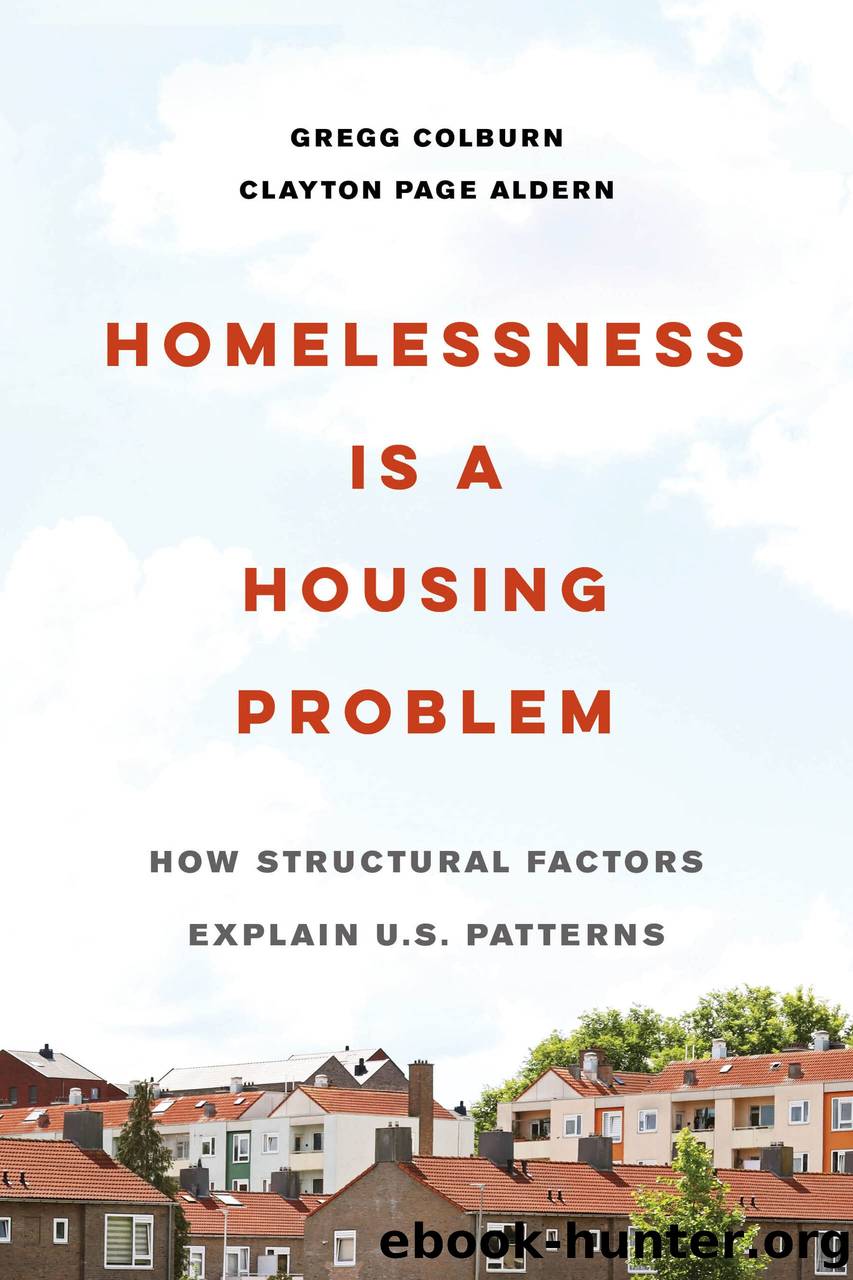Homelessness Is a Housing Problem by Gregg Colburn

Author:Gregg Colburn
Language: eng
Format: epub
ISBN: 9780520383791
Publisher: University of California Press
PART III
Conclusion
CHAPTER SIX
Typology
In a recent article for Bloomberg CityLab, Benjamin Schneider highlights how the âmodernâ notion of homelessness that began in the 1980s differs from prior eras, in which the experience was isolated to skid rows and single-room occupancy hotels (SROs). Describing this earlier, more limited scope of homelessness in prior generations, Nan Roman, chief executive of the National Alliance to End Homelessness, suggests in the article that âthere were people with mental illness, lots of people with substance abuse disorders, lots of poor people, all the same issues, but there was not widespread homelessness.â In contrast, when describing the modern manifestation, Roman states: âWhat changed was the housing.â1 In particular, scarce and expensive housingâa condition that has become more prevalent in the United States over the last few decadesâhas produced a crisis greater in scope. This much is in broad agreement with what youâve read so far. But as also described throughout this book, challenging housing market conditions are not evenly distributed throughout the country: Housing is more expensive and less readily available in some places. In this chapter, we begin to examine why these market conditions vary so considerably.
At the University of Washington, I (Gregg) teach a course that covers key questions in urban economics: Why do cities exist? Why is land in cities more expensive than in rural areas? Why do some cities grow while others shrink? In the class, one of my favorite exercises is to ask students to guess the Zillow Home Value Indexâa measure of home values in a given geographic areaâfor Cleveland, Ohio. To frame the conversation, I let them know that the equivalent estimate for Seattle is about $750,000. After giving them a moment to think, I invite students to shout out their answers: â$250,000!â â$175,000!â $300,000!â â$150,000!â Every time I deploy this exercise, I hear a similar distribution of responses. Inevitably, I get to shout backââYou are all WAY TOO HIGH!ââand to incredulous and quizzical looks, I disclose that the Zillow Home Value Index for Cleveland was about $50,000 in 2017 and had grown to just over $60,000 by 2019. The students are shocked. The index is less than 10 percent of the price of a home in Seattle. When I tell them the equivalent figure in San Francisco is nearly $1.4 million, the stark differences between U.S. housing markets become abundantly clear.
To understand the roots underlying the drastic variation in housing costs around the country, we note that housing in the United States is currently understood as a commodity: something that can be bought, sold, or traded and that fluctuates in price as a function of its supply and demand. Accordingly, in this chapter, we take a closer look at the demand for and supply of housing, as well as the powerful private and public forces that help shape each term. We argue that an analysis focused exclusively on the demand for housing is insufficientâjust as are attempts that solely encompass the supply side.
Download
This site does not store any files on its server. We only index and link to content provided by other sites. Please contact the content providers to delete copyright contents if any and email us, we'll remove relevant links or contents immediately.
Spare by Prince Harry The Duke of Sussex(5074)
Machine Learning at Scale with H2O by Gregory Keys | David Whiting(4190)
Fairy Tale by Stephen King(3221)
Will by Will Smith(2794)
Hooked: A Dark, Contemporary Romance (Never After Series) by Emily McIntire(2502)
The Bullet Journal Method by Ryder Carroll(2487)
Rationality by Steven Pinker(2291)
Can't Hurt Me: Master Your Mind and Defy the Odds - Clean Edition by David Goggins(2229)
It Starts With Us (It Ends with Us #2) by Colleen Hoover(2202)
Friends, Lovers, and the Big Terrible Thing by Matthew Perry(2123)
The Becoming by Nora Roberts(2089)
Love on the Brain by Ali Hazelwood(1965)
HBR's 10 Must Reads 2022 by Harvard Business Review(1778)
The Strength In Our Scars by Bianca Sparacino(1777)
A Short History of War by Jeremy Black(1763)
Leviathan Falls (The Expanse Book 9) by James S. A. Corey(1651)
515945210 by Unknown(1602)
A Game of Thrones (The Illustrated Edition) by George R. R. Martin(1591)
Bewilderment by Richard Powers(1540)
